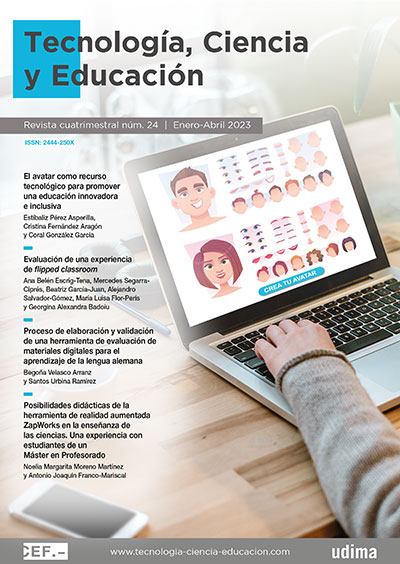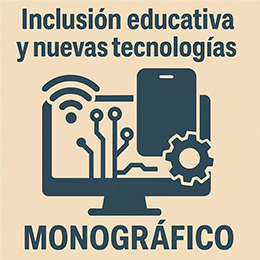Proceso de elaboración y validación de una herramienta de evaluación de materiales digitales para el aprendizaje de la lengua alemana
DOI:
https://doi.org/10.51302/tce.2023.1022Palabras clave:
material de enseñanza, multimedia educativo, enseñanza de idiomas, herramienta de evaluación, proceso de validación, certificación de exámenes, niveles MCERResumen
La selección de un material adecuado en la enseñanza del alemán es una condición clave para el éxito del aprendizaje. Una evaluación apropiada del material y su comparación con otros depende de la fiabilidad del método aplicado. En este trabajo se presenta la metodología aplicada a la elaboración de una herramienta de evaluación cuantitativa de materiales para la enseñanza del alemán. Por un lado, se definen los criterios que debe cumplir la herramienta, los cuales determinan el proceso de su desarrollo. Por otro lado, se identifican los ítems que se deben medir según los conocimientos, las competencias y, en un sentido amplio, las exigencias didácticas hacia estos objetivos, las limitaciones y las posibilidades que suponen los materiales digitales. En este artículo se explica el procedimiento aplicado a la agrupación de los ítems identificados, su forma de medir, evaluar y compararlos. Asimismo, se clarifica el procedimiento de su validación por expertos, las correcciones aplicadas según su resultado, y se detalla la implementación tecnológica elegida. Para verificar su viabilidad se aplica a tres materiales digitales de editoriales reconocidas. La herramienta permite evaluar en qué medida el material digital prepara al alumnado (hombres y mujeres) para la realización de los exámenes oficiales de alemán de los niveles A1-B2 definidos por el Marco Común Europeo de Referencia para las Lenguas (MCER). Los resultados han revelado aspectos mejorables con respecto a su adecuación como materiales digitales. Los tres materiales evaluados han obtenido 33, 39 y 47 puntos sobre 100. La aplicación de la herramienta resulta sencilla, permite una evaluación detallada y requiere cierta dedicación de recursos.
Agencias de apoyo
El contenido de este estudio de investigación procede de la tesis doctoral "Elaboración de una herramienta de análisis y evaluación de software para el aprendizaje de la lengua alemana", elaborada por Begoña Velasco Arranz, autora principal de este artículo. Santos Urbina Ramírez ha sido codirector de la citada tesis doctoral.
Descargas
Citas
Aguilar Juárez, I. y Morales Gamboa, R. (2011). Análisis de los Modelos de producción de CODIE (contenidos digitales educativos). En T. Morales Reynoso, C. Serrano Barquín, J. M. Serrano García, D. A. Miranda Gracía, E. Estrada Laredo, P. Troche Hernández y A. Rojas García (Eds.), 1.er Coloquio Internacional Aplicaciones Educativas de las Tecnologías de la Información y la Comunicación (pp. 569-583). Universidad de Guadalajara. https://www.academia.edu/11874006/An%C3%A1lisis_delos_Modelos_de_producci%C3%B3n_de_CODIE_Contenidos_Digitales_Educativos_
Akhvlediani, N. (2018). Analyse und Beurteilung von Lehrwerken für Deutsch als Fremdsprache im Sprachenzentrum der Staatlichen Schota Rustaveli Universität Batumi. Journal of Foreign Languages, Cultures and Civilizations, 6(1), 25-32. https://doi.org/10.15640/jflcc.v6n1a3
Akins, R. B., Tolson, H. y Cole, B. R. (2005). Stability of response characteristics of a Delphi panel: application of bootstrap data expansion. BMC Medical Research Methodology, 5, 1-12. https://doi.org/10.1186/1471-2288-5-37
Ausubel, D. P. (1968). Educational Psychology: A Cognitive View. Rinehart and Winstons.
Bernstein, N. y García Llampallas, C. (2015). Ein Verfahrensvorschlag zur Lehrwerkanalyse für DaF-Sprachenzentren. Deutsch Als Fremdsprache, 52(2), 103-113. https://www.fachportal-paedagogik.de/literatur/vollanzeige.html?FId=1064029#verfuegbarkei
Bhushan, N. y Rai, K. (2004). Strategic decision making: Appling the Analytic Hierarchy Process. Springer.
Bloomfield, L. (1933). Language. Holt.
Cabero Almenara, J. y Llorente Cejudo, M.ª C. (2013). La aplicación del juicio de experto como técnica de evaluación de las tecnologías de la información y comunicación (TIC). Eduweb. Revista de Tecnología de Información y Comunicación en Educación, 7(2), 11-22. https://dialnet.unirioja.es/servlet/articulo?codigo=4857163
Council of Europe. (2018). Common European Framework of Reference for Languages: Learning, Teaching, Assesment. Companion Volume with New Descriptors. https://www.coe.int/en/web/common-european-framework-reference-languages
Cova, Á., Arrieta, X. y Aular de Duran, J. (2008). Revisión de modelos para la evaluación de software educativos. Revista Electrónica de Estudios Telemáticos, 7(1), 93-114. http://ojs.urbe.edu/index.php/telematique/article/view/1969/1866
Eisenführ, F. y Weber, M. (1999). Rationales Entscheiden. Springer.
Figueras, N. (2008). El MCER, más allá de la polémica. Monográficos MarcoELE, 7, 26-35. https://marcoele.com/el-mcer-mas-alla-de-la-polemica/
Fries, C. (1955). American linguistics and the teaching of English. Language Learning, 6(1-2), 1-22. https://doi.org/10.1111/j.1467-1770.1955.tb00828.x
Funk, H. (2004). Qualitätsmerkmale von Lehrwerken prüfen-ein Verfahrensvorschlag. Babylonia-Zeitschrift Für Sprachunterricht Und Sprachenlernen, 3, 41-47. http://babylonia.ch/de/archiv/anni-precedenti/2004/nummer-3-04/qualitaetsmerkmale-von-lehrwerken-pruefen-ein-verfahrensvorschlag/
Galvis, A. (1992). Ingeniería de software educativo. Ediciones Uniandes.
García García, F. (2006). Contenidos educativos digitales: construyendo la sociedad del conocimiento. Red Digital: Revista de Tecnologías de la Información y Comunicación Educativas, 6, 1-29. https://dialnet.unirioja.es/servlet/articulo?codigo=1983578
Gisbert, M., Adell, J., Anaya, L. y Rallo, L. A. R. (2007). Entornos de formación presencial virtual y a distancia. Boletín de Rediris. https://www.rediris.es/difusion/publicaciones/boletin/40/enfoque1.html
Halbes, S. (2003). Der vergleichende Warentest zur Unterstützung des nachhaltigen Konsums Inhaltsverzeichnis. Lehr-und Forschungsbericht, 52. https://docplayer.org/184121440-Der-vergleichende-warentest-zur-unterstuetzung-des-nachhaltigen-konsums.html
Hennemann, D. y Verff, F. van der. (2013). Goethe-Zertifikat A2. Fit in Deutsch 2: Prüfungsziele. Testbeschreibung (3.ª ed. revisada). Goethe-Institut. https://www.goethe.de/pro/relaunch/prf/es/Pruefungsziele_Testbeschreibung_A2_Fit2.pdf
Holmberg, B. (1995). Enseñanza a distancia y autoaprendizaje de lenguas modernas: el uso de las nuevas tecnologías. En G. Ruipérez (Ed.), Enseñanza de lenguas y traducción con ordenadores (pp. 11-23). Ediciones Pedagógicas.
Hymes, D. (1972). On communicative competence. En J. B. Pride y J. Holmes (Eds.), Sociolinguistics: Selected Readings (Vol. 565, pp. 269-293). Penguin.
Ishizaka, A. y Nemery, P. (2013). Multi-Criteria Decision Analysis: Methods and Software. John Wiley & Sons Ltd. https://doi.org/10.1002/9781118644898
Krashen, S. (1981). Second Language Acquisition and Second Language Learning. Pergamon Press.
Littlewood, W. (1981). Communicative Language Teaching. Cambridge University Press.
Long, M. H. (1983). Native speaker/non-native speaker conversation and the negotiation of comprehensible input. Applied Linguistics, 4(2), 127-141. https://doi.org/10.1093/applin/4.2.126
Maijala, M. (2017). Was ein Lehrwerk können muss-Thesen und Empfehlungen zu Potenzialen und Grenzen des Lehrwerks im Unterricht Deutsch als Fremdsprache. Informationen Deutsch Als Fremdsprache, 34(6), 543-561. https://doi.org/10.1515/infodaf-2007-0602
Marquès Graells, P. R. (2002). Evaluación y selección de software educativo. Comunicación y pedagogía: Nuevas Tecnologías y Recursos Didácticos, 185, 31-37. https://dialnet.unirioja.es/servlet/articulo?codigo=306631
McLaughlin, B. (1990). Restructuring. Applied Linguistics, 11(2), 113-128. https://doi.org/10.1093/applin/11.2.113
Pastor Cesteros, S. (2004). Aprendizaje de segundas lenguas: lingüística aplicada a la enseñanza de idiomas. Publicaciones de la Universidad de Alicante.
Piaget, J. (1965). The Language and Thought of the Child. World Publishing Company.
Robles Garrote, P. y Carmen Rojas, M. del. (2015). La validación por juicio de expertos: dos investigaciones cualitativas en lingüística aplicada. Revista Nebrija, 9(18), 124-139. https://doi.org/10.26378/rnlael918259
Rommelfanger, H. J. y Eickemeier, S. H. (2002). Entscheidungstheorie. Springer Verlag.
Rösler, D. y Schart, M. (2017). Die Perspektivenvielfalt der Lehrwerkanalyse-und ihr weißer Fleck. Einführung in zwei Themenhefte. Informationen Deutsch Als Fremdsprache, 43(5), 483-493. https://doi.org/10.1515/infodaf-2016-0502
Schneider, W. (2007). Marketing. Physica-Verlag.
Sierra Bravo, R. (1991). Diccionario práctico de estadística. Paraninfo.
Skinner, B. F. (1957). Verbal Behaviour. Free Press.
Söhnen, S. (n. d.). Ordinal oder Intervall? Die Metrik von Ratingskalen. https://statistik-support-söhnen.de/2018/10/19/ordinal-oder-intervall-die-metrik-von-ratingskalen/
Soto Pérez, F. J. y Gómez Villa, M. (2000). EVALÚA: un instrumento de evaluación de recursos multimedia para la atención a la diversidad. http://diversidad.murciaeduca.es/tecnoneet/docs/2002/5-22002.pdf
Thangaratinam, S. y Redman, C. W. (2011). The Delphi technique. The Obstetritian & Gynaecologist, 7, 120-125. https://doi.org/10.1576/toag.7.2.120.27071
Velasco Arranz, B. (2019). Elaboración de una herramienta de análisis y evaluación de software para el aprendizaje de la lengua alemana. https://www.educacion.gob.es/teseo/mostrarRef.do?ref=1913679
Vögel, B. y Morita, M. (2005). Lehrwerkforschung, lehrwerkanalyse, Lehrwerkkritik, Lehren ohne lehrwerk. Neue Beiträge Zur Germanistik, 126, 74-93.
Vygotsky, L. S. (1978). Mind in Society: The Development of Higher Psychological Processes. President and Fellow of Harvard College.
Wilkins, D. A. (1972). Linguistic in Language Teaching. Arnold.
Descargas
Publicado
Cómo citar
Número
Sección
Licencia
Derechos de autor 2023 Begoña Velasco Arranz, Santos Urbina Ramírez

Esta obra está bajo una licencia internacional Creative Commons Atribución-NoComercial-SinDerivadas 4.0.


























